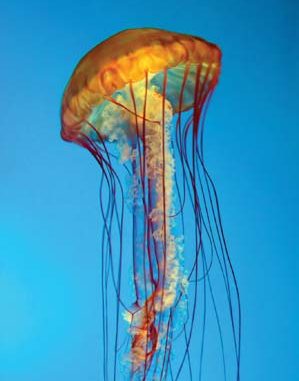
- Coelenterates are the first metazoan also called cnidarians (stinging animals).
- They have one continuous space or gastrovascular cavity called coelenteron.
- Coelenterates are aquatic (may be marine or fresh water).
- They are diploblastic animals and have a radially symmetrical body.
- Cnidarian are at tissue level of body organization and have a division of labor.
- Body wall:
- Body wall has outer ectoderm, inner endoderm or gastroderm with a non-cellular mesoglea in between the two.
- Different types of cells like endothelio-muscle cells, glandulo-muscle cells, interstitial cells, cnidoblasts or nematocysts, germ cells, sensory cells and nerve cells are present in the ectodermal layer.
- Gastroderm or endoderm contains five types of cells namely; endothelio-muscle cells or nutritive cells, endothelio-gland cells, interstitial cells, sensory cells and nerve cells.
- The interstitial cells are capable of developing into any of the other kind of cells like reproductive , glandular, stinging cells etc. as required. They are thus totipotent, i.e. they renew all the cells of the animal.
- Mode of nutrition:
- Coelenterates have a blind sac body plan. They are acoelomate (coelom is absent).
- Alimentary canal is incomplete, i.e. the gut cavity has a single opening called mouth.
- Mouth serves for ingestion and egestion and the anal opening is absent.
- They are carnivorous and can digest all food but starch.
- Digestion is unique with extracellular digestion followed by intracellular digestion.
- Body structure:
- Body is short and slender having tentacles encircling the mouth in one or two whorls.
- Tentacles serve for food-intaking, capturing the prey and defence.
- Tentacles in Hydra are hollow while solid in Obelia.
- They show polymorphism, i.e. two distinct forms (polyp and medusa) of individuals are seen.
- Other body systems:
- Nervous system is in diffused state with network of nerve fibers in the body walls and the tentacles. The brain is absent.
- Circulatory, respiratory and excretory systems are absent. Gaseous exchange and excretion occur through general body surface. They are ammonotelic.
- Locomotion and movement occurs with the help of smooth muscle fibrils in the epithelia or ectoderm.
- Specialized stinging cells called cnidoblasts are present which secrete hypnotoxin (poison).
- Sensory organs may be single or complicated, some with eye spots called statocysts.
- Reproduction:
- Reproduction is either asexual (by external budding) or sexual (by the formation of ova and sperm).
- Planula is a common larva but Ephyra larva are present in some animals.
- Their life cycle shows alternation of generation, in which a sexual free swimming medusoid generation alternates with an asexual sessile, usually colonial, polypoid generation.
- On the basis of dominance of zooids, coelenterates are divided into following three classes.
Class: Hydrozoa
- They are mostly marine but few are fresh water species.
- Body wall consists of two layers of cells, i.e diploblastic.
- Asexual polyp stage and sexual medusa stage are present
- Medusa stage is with velum.
- Polyp is the dominant stage.
- Mesoglea is simple and acellular and the gonads are ectodermal in origin.
- They have statocysts to maintain equilibrium.
- e.g. Hydra, Obelia, Physalia etc.
Class: Scyphozoa
- They are exclusively marine and triploblastic animals.
- They are free swimming and are solitary.
- Mesoglea is cellular and thick (jelly like) hence commonly called jelly fish.
- Polyp stage is rudimentary or absent.
- Medusa is domoinant, bell or umbrella shaped and lacks a velum.
- Larva is called Ephyra.
- Gonads are endodermal in origin.
- They have tentaculocytes to maintain equilibrium.
- e.g. Aurelia, Pilema etc.
Class: Anthozoa
- They are exclusively marine and are colonial forms.
- Body is triploblastic with mesoglea consisting of fibrous connective tissue and amoeboid cells.
- Polyp stage is present but medusa is absent.
- Gonads are endodermal in origin.
- Reef forming true stony corals belong to this class.
- e.g. Tubipora, Alcyonium, Heliopora, Gorgeonia, Pennatula etc.